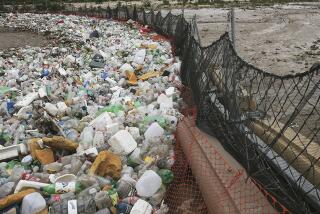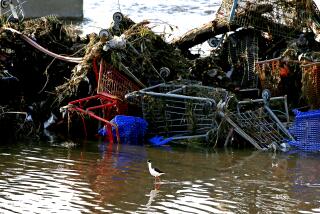British Beaches Violate Health Standards : Pollution: The nation pours 300 million gallons of sewage into the sea every day, more than half of it either raw or treated in a rudimentary way.
- Share via
LONDON — Swimming in the sea has been popular in Britain ever since King George IV took the plunge at Brighton early in the last century.
Anyone visiting Brighton in recent years would be wise to stay ashore. It is one of more than 140 British beaches too polluted with sewage and other muck to meet European Community standards.
Nearly 25% of Britain’s 446 beaches designated for swimming fell short of the standards last year, according to the recently published “1991 Good Beach Guide.”
The guide, published by the Marine Conservation Society, lists some of the nation’s prettiest and cleanest sites. It also reminds beachgoers of pollution problems that caused the European Commission to begin legal proceedings against Britain last June in the European Court of Justice.
Every European country has pollution problems, and British beaches are hardly the worst. The European Commission decided to take Britain to court first because it felt that the government was moving too slowly to meet directives that took effect in 1985.
Britain has more coastline than any other EC member and pours at least 300 million gallons of sewage into the sea every day, more than half of it either raw or treated in a rudimentary way.
Much of the sewage disposal system dates from the late 19th Century, when it was assumed that the sea was a natural disinfectant.
Some discharge lines are so short the sewage pours out above the waterline. About six years ago, water boards in search of a cheap solution began building longer pipes to carry the sewage farther from shore.
Studies since have shown that some bacteria and viruses can survive two or three days or longer in salt water and may be washed back toward shore.
Britain originally designated only 27 of its beaches for testing, seven fewer than landlocked Luxembourg. Britain virtually ignored testing rivers or lakes.
France designated 1,400 beaches and Italy submitted 1,100, according to Carlo Ripa di Meana, the EC environment commissioner.
Britain also let various water authorities, which are responsible for much of the pollution, choose the testing methods.
Denmark, with coastal pollution problems as serious as Britain’s, tests water by far stricter standards than the EC asks, tests more beaches than required and bars swimming at polluted beaches.
Lord Clinton-Davis, the former EC environment commissioner, said the British government had spent a lot of time telling the press the standards were too strict, but had done hardly anything about the filth.
“The proceedings are being taken by the present commissioner because my patience and his patience is exhausted,” he said.
Clinton-Davis said Britain delayed compliance because it would have interfered with plans to privatize the water authorities. The fear was that investors would not buy shares if they knew the companies had to bear cleanup costs.
Since last June, the government has committed more than $5 billion to a long-term cleanup effort. It pledged to have 95% of swimming water at EC standards by 1995.
Britain does not require water quality to be posted on public beaches, as France does, so people don’t know whether they are swimming in sludge.
Each summer, British doctors anticipate increased “sewage sickness,” a list of illnesses blamed on swimming in contaminated water.
Scientists are convinced that the presence of bacteria and viruses in polluted sea water causes illnesses ranging from upset stomachs and sore throats to polio and hepatitis.
Evidence from the United States, the Mediterranean and a small study by the University of Surrey in Britain suggests an increase in symptoms such as vomiting and upset stomachs associated with swimming in polluted water.
A study conducted at Blackpool last summer found that children swimming in contaminated water suffered from vomiting, diarrhea, fever, skin rashes, lack of energy and loss of appetite.
More to Read
Sign up for Essential California
The most important California stories and recommendations in your inbox every morning.
You may occasionally receive promotional content from the Los Angeles Times.













